Electricity 101 – The Basics and Then Some
10mins read • Bryan Clark
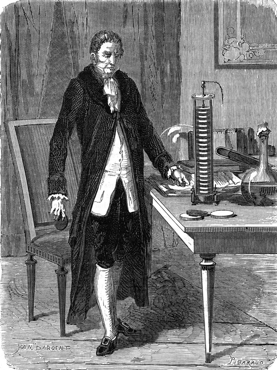
Jump To Section
The Mystery of Electricity
Electricity Basics
Electricity is one of the most important things we deal with on a daily basis; however, most people do not know what it is. The average person can go their whole life without knowing and not suffer at all from it. That being said in my world as an audio engineer who has specialized in live sound, I find it incredibly useful to know about it. After all we need power for our gear and once a signal has been captured into a microphone it is converted into electricity in one form or another.
In this blog I plan on discussing the basics of electricity: what it is, how it’s measured, as well as some terminology that you may have heard before but didn’t quite understand. I will try to not get too scientific and will only use math when necessary. I hope I didn’t scare you with the ‘M’-word. I will often be showing something to a class and mention that I have math to prove something. That is most often met with everyone looking away and trying hard not to make eye contact. Relax, it won’t be that bad.
What is electricity? Simple question that actually has a simple answer: Electricity is the movement of electrons from one atom to the next. In fact, it’s the movement of billions of electrons from one atom to the next.
This explanation is based on the Bohr’s model of the atom created by Neils Bohr in 1915. If you remember any of your high school science classes you’ll know what I mean. An atom consist of three parts: a proton, a neutron and an electron. The protons and neutrons are housed in the inner part of the atom called the nucleus and the electrons orbit around that. We’re not going to get into quarks and stuff and we will not talk about string theory or super string theory. Just protons, neutrons and electrons.
Now the number of electrons an atom has is important and depending on that number there could be numerous layers or orbits around the nucleus. The only one we’re interested in is the outer most layer called the valence shell. The valence shell has a rule that says it can only have up to eight electrons. The number of electrons on the shell will determine whether it is considered a conductor, insulator or semi-conductor. Atoms with one valance electron are considered conductors as they have an electron it can freely give away. Atoms with eight valence electrons are considered insulators as they do not have a place for and electron to land. Atoms with three, four or five valence electrons are considered semi-conductors.
But back to keeping it simple: electricity is the movement of electrons from one atom to the next. With that being said, we need to talk about ways we can measure it. In order to do that we need to introduce some more terminology. This is where volts, amps, resistance/impedance & watts come into play. Most people have heard those terms before, but may not understand what they are. So here we go…
Volts

So if electricity is the movement of atoms from one atom to the next, then what is causing them to move? Volts are. Volts, aka electromotive force (EMF), are simply the pressure pushing the electron along their path. Named after Alessandro Volta who created the Voltaic Pile which is an early form of battery. I like to use the water faucet analogy with electricity. In this case voltage would be the same as the water pressure in your home. Without it water wouldn’t flow and without voltage electrons would not flow.
Amperes, Amperage & Amps

All three of these things are the same thing. They are named for the French physicist Andre-Marie Ampere. An amp is simply how many electrons are moving past a point in a second. So in our water faucet analogy amps would be how much water is coming out of the faucet per
second.
Now the number of electrons moving is quite astounding. One amp consist of 6.24 x 1018electrons. That’s 6.24 quintillion! Most household breakers allow 15 of those to pass before tripping. The disconnects we use in live sound can allow for 100A, 200A or 400A. To me that is amazing.
I should probably point out the amperage is often referred to as current.
Resistance and Impedance
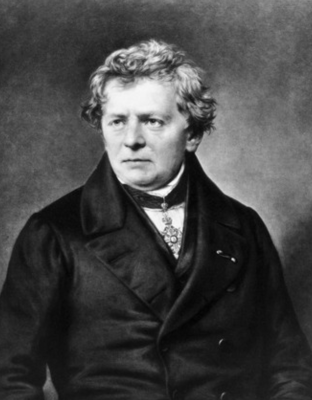
Resistance/Impedance
Resistance is simply the opposition to the flow of electrons. In our water faucet analogy, if you loosen the handle the resistance decreases and more water (amps) comes out. If you tighten the handle the resistance increases and less water comes out.
The unit of measure for both resistance and impedance is the Ohm, represented by the greek letter omega Ω. Named after Georg Simon Ohm who was a German physicist and mathematician.
Resistance can come from a number of sources. It could just be the material that the electricity is passing through. For instance in speaker wire the thinner the wire the more resistance (actually impedance) is present. The thicker the wire the less resistance. In electronic circuits there are many components that cause resistance. Resistors, potentiometers, photo-resistors are some examples.
Most of these devices take electrical energy and convert it to heat. An example of this would be incandescent light bulbs. Even though most people are switching or have switched to LED’s instead of incandescent bulbs, these things were the only option for a long time. The way they worked is that they would take the electricity from your home and run it through a filament made of tungsten. Tungsten created a lot of resistance to the electricity. So much so that when a current was applied the filament would glow giving off light as well as heat.
So what is impedance? This has to do with what kind of current we’re talking about. There are two types: Direct Current (DC) & Alternating Current (AC). Both are very useful. In fact we all use both everyday. I’ll probably write another blog about current, but for now DC refers to current that moves in one direction and AC refers to current that changes directions at a fixed rate. That rate is 60 times per second in the US. Resistance is the opposition to the flow of current in DC where impedance is the opposition to the flow of current in AC.
Watts, Wattage & Power
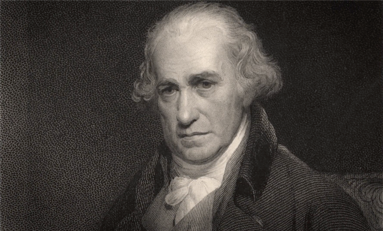
Wattage is the amount of work we can get out of a circuit and it is calculated by multiplying volts x amps. In the water analogy if our faucet was on and we had a small water wheel (the type you’d see at watermills that use the movement of water to perform a task) the amount of energy causing the movement of that wheel would be wattage.
Wattage is represented by the letter W and sometimes the letter P, which stands for power. It was named after James Watt who was the inventor of the steam engine.
Interesting note: 745.7W = 1 horsepower. Meaning that a 10hp motor will consume 7457 Watts. If that motor was hooked up to a wall outlet that had 120 Volts it work consume 62.14 amps.
Ohm's Law & Watt's Law
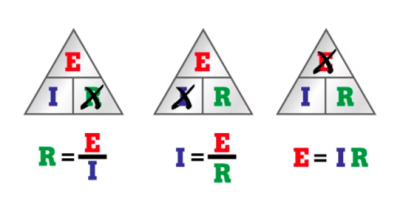
Georg Ohm is best known for his “Ohm’s Law”. Ohms law states that the current flow through a conductor is directly proportional to the voltage and inversely proportional to the resistance. So the more voltage the more current, but the more resistance the less current. Ohm’s law is more commonly known as the mathematical formulas needed to calculate the variables in an electrical circuit.
In this chart the letters represent the following: E = electromotive force EMF or voltage, I stands for intensity and represents amperage, and R stands for resistance. So if you know any of the two values you can calculate the other.
If you are trying to find the resistance of a circuit, cover the R and it shows you that it is Volts divided by Amps. To find the Amps, cover the I and it shows you that it is Volts divided by Resistance. To find the Volts, cover the E and it shows you its Amps x Resistance.

Watt’s law uses the techniques to help calculate Power or Wattage. In this chart P stands for Power (Watts), I stands Intensity (Amps), V stands for Volts. The two sets of formulas can be combined into the chart you see below.
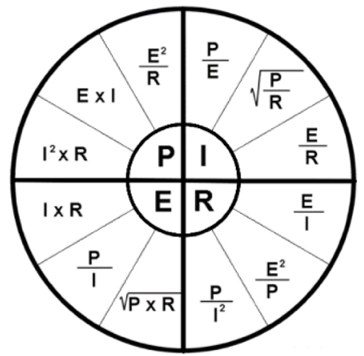
I found this chart useful enough to tattoo it on my forearm. I can’t tell you how many times I’ve referenced it to figure something out.
Next Steps
So what now? Well, this is the beginning of the discussion. You have to be aware of what these things are before we can have a discussion on how and why they are useful. Moving forward I’m looking to write more about the application of these concepts and when and where they appear in terms of audio. Which is everywhere. These things are in every aspect of audio from the microphone to the console to the amps and speakers. If you’ve ever hooked something up and you did not get the result you were expecting, chances are the explanation lies in the principles laid out above.
See you next time.
-Scott Brewer


